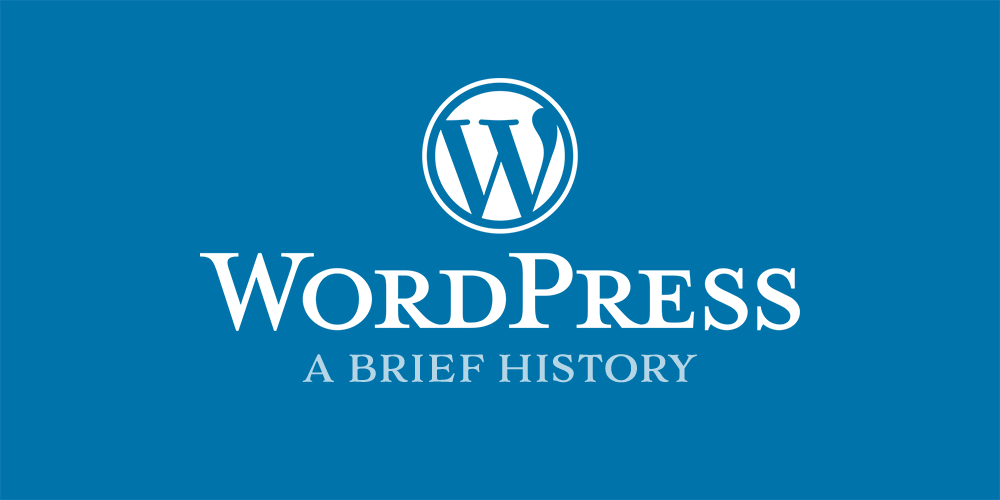History of WordPress: The Good, The Bad & The Ugly

Ten years ago, WordPress was just a fork. Nope, not the kind you would use at dinner. In the world of software developers, a fork…
“…happens when developers take a copy of source code from one software package and start independent development on it, creating a distinct piece of software. The term often implies not merely a development branch, but a split in the developer community, a form of schism.” – Wikipedia.
At the age of 18, Matt Mullenweg – the programmer son of a software engineer – started using b2 aka cafelog to share photographs he took while on a trip in Washington, DC. The blog? Photomatt.net, which redirects to Matt’s official blog, Ma.tt.
One year later, Michel Valdrighi – the guy behind b2 – stopped releasing updates to the platform, a move that prompted Mullenweg to fork the b2 software (to bring it up to date and accommodate his blogging needs). Oh yeah, Matt was blogging actively at the age of eighteen, and this is what he said in a blog spot, The Blogging Software Dilemma, that marked the birth of WordPress ten years ago:
… My logging software (meaning b2) hasn’t been updated for months, and the main developer (Michel Valdrighi) has disappeared, and I can only hope that he’s okay.
… Fortunately, b2/cafelog is GPL, which means that I could use the existing codebase to create a fork, integrating all the cool stuff that Michel would be working on right now if only he was around…
I’ve decided that this the course of action I’d like to go in, now all I need is a name. What should it do? Well, it would be nice to have the flexibility of MovableType, the parsing of TextPattern, the hackability of b2, and the ease of setup of Blogger.
Someday, right?
I contacted Matt Mullenweg over email but I guess he is really busy, or he just gets a bazillion emails everyday, so I’m not complaining because I never got a reply. Haha. But this is the story of one dedicated man and how his vision transformed the world of web publishing forever.
Matt’s blogging software dilemma post got a reply from Mike Little, now a WordPress specialist and a big name in the WordPress community. At 3:58 PM on January 25, 2003, Mike posted:
Matt,
If you’re serious about forking b2 I would be interested in contributing. I’m sure there are one or two others in the community who would be too. Perhaps a post to the B2 forum, suggesting a fork would be a good starting point.
Let’s go back to our history lesson.
Early Founders

Matt
Matt was all about eliminating the challenges that authors faced where web publishing was concerned. His vision was to make web publishing easy for you and me.
He tried various blogging platforms including Text Pattern and Movable Type before settling on b2. But with the disappearance of Michel, Matt was left in a stalemate.
He wasn’t prepared to let go of his blog, so he decided to fork b2. You could also argue he saw his opportunity right there and grabbed it.
Mike agreed with him, and together they pushed WordPress from a mere fork used by less than ten (10) people to the mammoth blogging script it is today.
This step made Matt Mullenweg and Mike Little the earliest founders of what is now known as WordPress. I will add Christine Tremoulet to that list because WordPress branding was her idea. So yeah, Matt and Mike had the groundwork covered, but without Christine WordPress wouldn’t have the name we know and love today.
WordPress Timeline
On 1st April, 2003, Matt created a b2 fork and stored the same on Sourceforge<.

WordPress Fork
From here, Matt focused on standardizing the code and HTML semantics. Keep in mind that his overall goal was to make the platform simple for the average Joe without PHP or MySQL skills.
Therefore, Matt made semantic changes to the index.php, which is the file that loads your blog’s homepage.
He was aiming for XHTML strict compliance, which gives WordPress websites the ability to load fairly well on different browsers and devices. What that means is he eliminated a few redundant tags and fixed a couple of known b2 issues.
Where was Michel all this time? Nobody knows.
Three weeks later, Mike repopulated files in the b2 fork to fix missing files. This became Mike’s first commit, which also came with the excerpt feature that allows WP users to append custom summaries in RSS feeds amongst other places. At about the same time, Matt introduced his first feature, the WP-Texturize, which made text “…more typographically correct” according to Siobahn McKeown.
In the same month, Matt launched WordPress.org, which had support forums, schematic documentation and a development blog. On the homepage, there was this tagline:
“WordPress is a semantic personal publishing platform with a focus on aesthetics, web standards and usability.”
This was Matt’s vision and soon enough, WordPress.org became an ever-growing WordPress community.
The website made it easier for users to get involved. It never mattered, most people who tried WordPress found it exciting and found ways and got involved. The community grew rapidly and it comprised of bloggers, developers and non-developers.
The support forums were growing in popularity by the day. All the same, they weren’t enough, so there was a need to create official WordPress documentation. This would happen seven months later in December 2003 when WordPress Wiki was born out of necessity.

MediaWiki
The wiki quickly outgrew the support forums because “…it felt like a much more informal and freeform way to create documents.”
The wiki was built on MediaWiki, the same script behind huge projects such as Wikipedia. Later on WordPress Wiki was christened “Codex“, a term that was suggested by Monkinetic in a WordPress chat room.
That was not the end of it, Matt and Mike would make over a hundred commits to WordPress. This means the WordPress repository at Sourceforge kept growing and with the growth came new features such as changes to the administration panel, improvements to the installation process, Mike’s b2links hack, and WordPress’ branding.
Mike and Matt were especially keen on creating an easy installation process that WordPress is famous for. Michel’s b2 involved a complex installation and configuration process because, according to himself, he was still learning PHP when he developed b2. In other words, Matt’s and Mike’s early work involved a lot of refactoring Michel’s code and making tweaks.
A few weeks after Matt announced he would fork b2, b2 had several other forks including b2evolution, which was forked by Francois Planque, a developer from France, and b2++, which was forked by Donncha O Caoimh from Ireland, who was keen on developing a templating system that would separate code from presentation. This would make it easier for users to modify the design of their sites. Matt felt Donncha’s templating system was “so painful” he wouldn’t want to subject it on anyone, so WordPress’ templating system was not implemented until 2005.

WordPress
With various forks popping up all over the place, Michel’s decision made WordPress the official branch of b2. That was on May 23rd, 2003. Four days later on May 27th, 2003, WordPress 0.7, the first version of WordPress was released.
While most of the underlying code was b2’s, users were treated to new features including the famous WordPress Links Manager, which gave bloggers the ability to create blogrolls.
The release of WordPress 0.7 fueled the growth of WordPress user base. On May 29th, 2003, Matt invited Donncha to merge b2++ with WordPress. Donncha was glad to join hands, raising the number of developers to three. Francois on the other hand wasn’t as enthusiastic and he felt that WordPress was “…too much work for too little benefit.”
Matt is an astute researcher, so he visited b2 forums to understand what bloggers and web developers desired. When WordPress 0.71 was released a month after WordPress 0.7, it had new features designed to satisfy bloggers and developers.
These improvements included upgrades to the admin panel and the updating process together with improvements to the Links Manager. WordPress 0.7 bugs and security issues were fixed, and the OPML import functionality was introduced.
In the same year (2003), Alex King and Dougal Campbell jumped on the WordPress bandwagon. Dougal made his first commit in September. He enhanced the RSS functionality by using a HTTP 304 Response to reduce server load in turn making WordPress faster. Alex became a contributing developer in August, 2003, but his suggestions to surround content with HTML tags was never used, as they were superseded by the plugin system.

The Great Renaming – Muppets Edition
Late in 2003, Matt started to rename “b2” files to “wp-” in a process that Alex King called The Great Renaming. This ‘great renaming’ caused a number of inconsistency issues but it was important for the future of WordPress. Matt also consolidated most of the files into the wp-admin and wp-includes folders.
As 2003 was coming to a close, Ryan Boren joined the community. He was a past contributor to open source projects such as Linux kernel and Gnome. His contributions to WordPress led to the development of the plugin system. Matt was the first to create a “useful” plugin – the blogtimes plugin – which generated a report showing when posts were created. Earlier, he had developed the Hello Dolly plugin to demonstrate how plugins could be used.
See Matt Mullenweg’s other plugins here.
In May 2004, a year after the first release but now with an active and growing community, the developers released WordPress 1.2 that saw the introduction of major improvements.
And thanks to a drastic licensing move by Six Apart, the company behind Movable Type, WordPress downloads shot from 8,000 in April to 19,000 in May.
The theme system that we’re very fond of today was released in 2005 alongside static pages. This was all bundled in WordPress 1.5 alias Strayhorn. A new backend UI (user interface), persistent caching functionality and new user roles were later introduced in WordPress 2.0 (Duke) in the same year. I will put it out there just so you know, all WordPress versions are named after Jazz legends.
2006 wasn’t as eventful as the previous years development-wise and no new versions were released. But investors were beginning to take Matt seriously, so 2006 saw the first funding partners join the WordPress team. The millions of dollars they brought in kept the company afloat, and more funding came in 2008 at a time when WordPress had only eighteen employees.
Ten years after the first version was released, WordPress has more than two hundred employees and over twenty thousand contributing developers all over the world.
What’s more? WordPress powers over sixty (60) million websites, which is about eighteen percent (18%) of the web. That number keeps growing by a hundred thousand (100,000) sites everyday. The platform is ever evolving and on 12th December, 2013, Automattic released WordPress 3.8. Have you updated your platform yet?
Statistics: Forbes
Matt’s WordPress Awards

Matt – a connoisseur of jazz music – has received many awards. In 2007, he was named the sixteenth most-important person on the internet by PC World. In 2008, he was awarded the Information Technology Innovator Award by the Temple University Fox School of Business Management. In 2009, he was named an honorary of the University Philosophical Society. In the same year, he was awarded Overall Best Open Source CMS Award for his work with WordPress.
Then the awards just kept coming and late in 2012, Matt made it to the 2012 Forbes’ 30 Under 30 in Media list. Besides that, Matt is a well-known supporter of several philanthropic organizations such as Free Software Foundation, Innocence Project, Electronic Frontier Foundation and Archive.org.
I could go on and on about WordPress and Matt but that would require a whole post altogether. So this here marks the end of our history lesson today. Shall we take a look at the good, the bad and the ugly of WordPress?
The Good
Ease of Use
Installing, configuring (or lack thereof) and using WordPress is easy. You can add new posts, pages, images, et cetera quickly without a problem.
This means you can concentrate on important issues since little effort and time are required to format and design your website.
Flexibility and Accessibility

WordPress is flexible
Seeing that WordPress is browser-based, you can log into your WP website from anywhere in the world provided you have an internet connection.
With the introduction of WordPress for mobile, you can even log in and edit your website from a mobile device.
WordPress is SEO Friendly
Search engine spiders have a soft spot for WordPress since the code is simple and clean, making it easy for search engines to crawl and index your content. Additionally, you can optimize your site with keywords, meta in the head section, tags and SEO plugins such as WordPress SEO by Yoast.
No FTP Clients or HTML Editing Required
You don’t need HTML knowledge to create or edit posts and pages. It’s all drag and drop now. What’s more, you can upload files to your WordPress site without FTP software. It’s a breeze creating with WordPress.
A Ready-To-Go Blog
WordPress was originally built as a blogging platform, meaning once you instal it, you don’t need a separate blogging software. With WordPress, you can create a blog, a website or an amalgamation of the two.
The Bad & The Ugly
Security Loopholes
PHP is susceptible to numerous security issues and bugs. This is the reason why WordPress releases regular updates; the why it’s important to keep your WordPress platform updated at all times. Without these updates, your website could be hacked and you would cry foul. Haha. Just update your WordPress platform, and if you really want to be safe invest in a good backup system like VaultPress or think about a security service like Sucuri.
Modifying Templates Requires Knowledge of PHP

php = elephant in the room
Unfortunately, there are modifications you cannot implement using plugins no matter what you try. These modifications require that you edit the template files of your WordPress theme.
The only problem is you need to have passable knowledge of PHP or you’ll break something.
Plugins Incompatibility
When a new version of WordPress is released, authors take time to update their plugins, which results in incompatibility issues. This can lead to functionality problems especially if you rely on a plugin (or plugins) to run important processes on your WordPress site.
History of WordPress Resources
If you would like to read more on the history of WordPress, checkout the official ebook: On Forking WordPress, Forks in General, Early WordPress and the Community [Chapter III]
A history lesson goes well with a discussion, so spread the word and leave a comment in the section below to continue the conversation. In the meantime, I will check if Matt got my email for our next history lesson 🙂
Happy holidays!



Great post, Freddy.
Thanks for the kind words Bruno!
Great article, indeed. Per the security, while it can be suscetible out of the box, I find that after just a few hardening techniques (.htaccess, giving WP it’s own directory, strong password and not using admin as the user), it’s not one bit less secure than any other PHP based CMS. Just my $0.02.
True that. Thanks for your $0.02 Lars 😉
Really enjoyed reading this post. You just spoon-fed some quick historical stuff about WordPress.
Thank you Priyanka!
Good post Freddy. The only thing I’d change is “This is the reason why Automattic releases regular updates” Automattic doesn’t release updates for WordPress. It would be more accurate to say WordPress releases updates for WordPress. Automattic doesn’t own or operate the WordPress.org project. They just have employees that contribute time and effort to it.
Good call!
Seems like moving to 3.0 (Thelonius Monk) in June of 2010 was a complete game-changer for WordPress as a full-fledged CMS (all “growed-up” from glorified blogging software), & should be chronicled… just another opinion, fwiw. 🙂
Thanks for passing by and sharing with us 🙂
I love WordPress!
What a fantastic post, I was looking to write something similar but this covers it all in some detail. Thank you